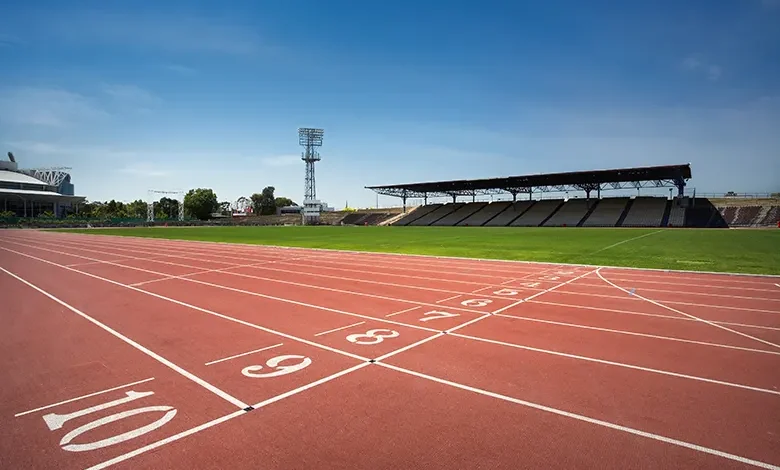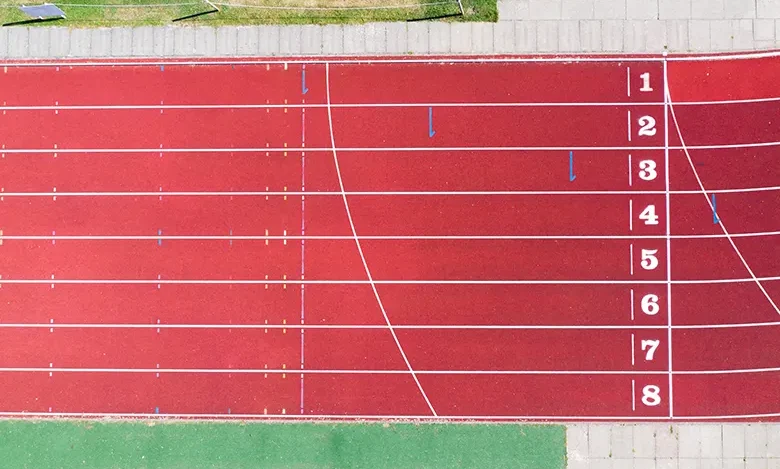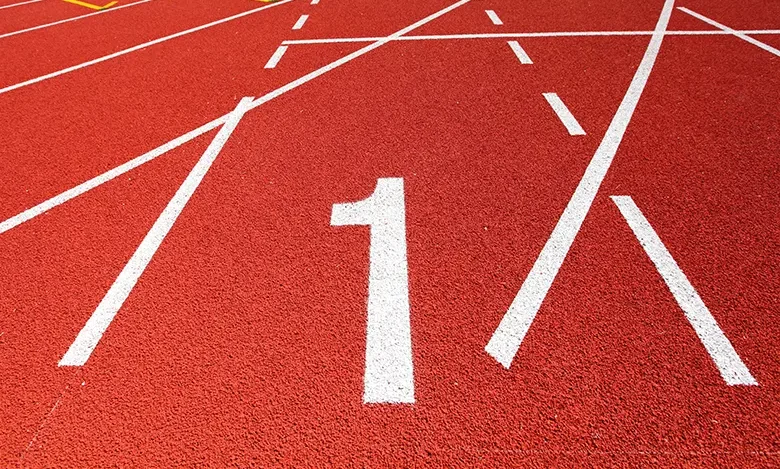
Have you heard of specialized courses where professional sprinters run at a million miles per hour? These are called running tracks or (in other words) athletic tracks and can be found all over the place, especially around football fields, on large high school and university campuses. But do you know what the dimensions of a running track are?
A running track is typically 400 meters in length, with two parallel straightaways and two curves with identical radii.
The length of the straightaways is 84.39 meters, and each curve has a radius of 36.50 meters. While these are the standard dimensions, variations can occur due to local regulations or design choices.
Running tracks provide athletes with a consistent and predictable surface for training and competition and can be divided into smaller segments for various purposes.
What Is A Running (Athletic) Track?

A running track is a specialized oval-shaped course designed for both training and competitive track-and-field events. It typically features a high-quality rubberized surface that functions like a springboard, giving runners an added boost with each stride they take.
This surface is also designed to absorb some of the impact when a runner falls, reducing the risk of injury. Interestingly, in ancient Greece, running tracks were much shorter than modern-day tracks, measuring only around 600 feet or about 45% of the length seen today.
However, because there was no standardized measurement for a foot at the time, the exact length of these tracks varied from city to city. Today, all official international running tracks must meet specific measurements set by the World Athletics organization (formerly known as the IAAF International Association of Athletics Federation), and this standardization also applies to high school and university tracks.
Running (Athletic) Track Dimensions
When it comes to running tracks, there are various lengths available.
However, the most common length measures in at 400 meters or 1,312.34 feet. If you’re looking to design and construct a 400-meter-long track, there are specific dimensions that you’ll need to follow. These measurements include the width of the lanes, the radius of the curves, and the location of the exchange zones for relay races.
Ensuring that your track meets these precise specifications is crucial if you want it to be suitable for official international competitions. Thankfully, most high schools and universities use the same measurements, which means that athletes can train on tracks that mimic the exact conditions they’ll face when competing at the highest level.
|
Measurement |
Meters |
Feet |
|
Track Length |
400 |
1,312.34 |
|
Overall Length |
196.91 |
580.41 |
|
Overall Width |
95.5 |
303.48 |
|
Straight Track Length |
84.39 |
276.87 |
|
Inner Radius |
36.5 |
119.75 |
|
Lane Width |
1.22 |
4 |
|
Total Area |
14,594 m2 |
157,092 ft2 |
Although there is some degree of flexibility when it comes to running track measurements, the basic shape and design of the track should remain consistent across all venues.
While minor differences in measurements may be permitted by the IAAF (International Association of Athletics Federations) the main focus is on ensuring that the track is oval-shaped and that it meets the necessary standards for safety and fairness.
This means that whether you’re training at a local high school or competing in an international event, the fundamental structure of the track will be the same. From the size and slope of the curves to the width of each lane, every aspect of the track has been carefully calibrated to provide athletes with the ideal environment for achieving their maximum potential.

The starting lines for the 300 meter and 400 meter races are located at different points on the track, with the former starting at the end of the first turn and the latter beginning at the start of the first turn. The starting lines are positioned perpendicular to the shape of the track for both races.
Meanwhile, the 100 meter race takes place on a straight path that starts slightly off-center from the end of the second bend. As for the 200 meter race, it starts at the beginning of the second bend and ends at the 400 meter line.
However, due to the layout of the track, the starting positions for the 200 meter racers are uneven and are referred to as scratch lines.
The table below details how far each lane is into the bend relative to the 200 meter line.
|
Lane |
Meters |
Feet |
|
1 |
0 |
0 |
|
2 |
3.52 |
11.55 |
|
3 |
7.35 |
24.11 |
|
4 |
11.19 |
36.71 |
|
5 |
15.02 |
49.28 |
|
6 |
18.85 |
61.84 |
|
7 |
22.68 |
74.41 |
|
8 |
26.52 |
87.01 |
What Track and Field Categories Are Held on a Running Track?

Sprinting
Sprinting is an activity where athletes run short distances of 100 meters, 200 meters, or 400 meters at breakneck speeds. Racers in the 100 meter and 400 meter categories start from the same point while those competing in the 200 meter dash have staggered starting points. The 300 meter event is rare and occurs towards the end of the first bend, finishing at the 400-meter line.
Middle Distance Running
These races require runners to circle the 400-meter long track multiple times covering distances between 800 to 1,500 meters. Runners can compete in events that vary from 1 mile (1.61 kilometers) to 3 kilometers (1.86 miles). Racers can begin from scratch lines set on any of the two bends or from the 400 meter line depending on the length of the race.
Long Distance Running
Long-distance running is a test of an athlete’s stamina and velocity. Some events require racers to cover distances of either 5,000 or 10,000 meters (16,404.2 or 32,808.4 feet). However, these events are typically reserved for international tournaments. National events start with a 3,000 meter race that involves circling the 400 meter long track 7.5 times, starting from the 400-meter point and ending at the 200 meter line.
Hurdling
In hurdling events, racers jump over hurdles to cover distances ranging between 100 to 110 meters (328.08 to 360.89 feet). The height of the hurdles varies based on the category. In men’s hurdling events, the hurdles are 1.067 meters (3.5 feet) high, while female hurdlers have to jump over 0.838 meter tall (2.75-foot) hurdles. Races for hurdles begin with an offset course designed for 100 meter dashes.
Relay Races
Relay races are team events where four athletes team up to compete. The baton is passed from athlete to athlete after covering a certain distance. The most common relay race categories are the 4 × 100 meters and the 4 × 400 meters. The starting lines are staggered to follow the scratch lines mentioned earlier.
What’s in the Middle of Running Tracks?

Running tracks are oval in shape with ample space in the middle. This space can conveniently house an entire soccer or football field. However, during track and field tournaments, this area can be reserved for other events such as jumping and throwing.
The running track and the middle area will only be used simultaneously during training. This is done to prevent javelin throwers, discus throwers, and shot put throwers from causing injury to unsuspecting runners adjacent to the thrower’s starting points.




What is the total area required to build an 8-lane running track according to international standards?
Regard
4880 m²
How to calculate the different distances covered on each running track in one full lap?
The following formula can be used:
D_k = 400 + (k – 1) x 2.44
Where:
– D_k = Distance for one full lap in the k-th lane (in meters)
– 400 = Distance for one full lap in the innermost lane (Lane 1), which is 400 meters
– k = Lane number (starting from 1 for the innermost lane)
– 2.44 = The additional distance for each lane (approximately the width of each lane, which is around 1.22 meters, and the circumference increases by roughly twice this value as you move out)
Example:
Lane 4:
D_4 = 400 + (4 – 1) x 2.44 = 400 + 7.32 = 407.32 meters etc…
Wow that is incredible post!